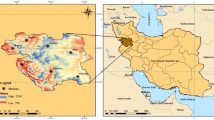Abstract
The paper considers the possibility of thunderstorm forecasting using only dynamical and microphysical parameters of the cloud, simulated by the 1.5D model with further processing by machine learning methods. The problem of feature selection is discussed in two aspects: selection of the optimal values of time and height when and where the output model data are fixed and selection of fixed set of the most representative cloud parameters (features) among all output cloud characteristics. Five machine learning methods are considered: Support Vector Machine (SVM), Logistic Regression, Ridge Regression, boosted k-nearest neighbour algorithm and neural networks. It is shown that forecast accuracy of all five methods reaches values exceeding 90%.
Access this chapter
Tax calculation will be finalised at checkout
Purchases are for personal use only
Similar content being viewed by others
References
Information on https://www-03.ibm.com/press/us/en/pressrelease/49954.wss
Information on https://arnesund.com/2015/05/31/using-amazon-machine-learning-to-predict-the-weather/
Information on https://yandex.ru/company/technologies/meteum/
Stankova, E.N., Balakshiy, A.V., Petrov, D.A., Shorov, A.V., Korkhov, V.V.: Using technologies of OLAP and machine learning for validation of the numerical models of convective clouds. In: Gervasi, O., et al. (eds.) ICCSA 2016. LNCS, vol. 9788, pp. 463–472. Springer, Cham (2016). https://doi.org/10.1007/978-3-319-42111-7_36
Stankova, E.N., Balakshiy, A.V., Petrov, D.A., Korkhov, V.V.: OLAP technology and machine learning as the tools for validation of the numerical models of convective clouds. Int. J. Bus. Intell. Data Min. 14(1/2), 254–266 (2019)
Abramovich, K.G., et al.: Guide to forecasting meteorological conditions for aviation, Goskomgidromet, Moscow (1985). (in Russian)
Stankova, E.N., Grechko, I.A., Kachalkina, Y.N., Khvatkov, E.V.: Hybrid approach combining model-based method with the technology of machine learning for forecasting of dangerous weather phenomena. In: Gervasi, O., et al. (eds.) ICCSA 2017. LNCS, vol. 10408, pp. 495–504. Springer, Cham (2017). https://doi.org/10.1007/978-3-319-62404-4_37
Information on https://www.microsoft.com/en-us/research/wp-content/uploads/2016/11/KDD_2014_keynote_horvitz.pdf
Baik, J.-J., Paek, J.-S.: A neural network model for predicting typhoon intensity. J. Meteorol. Soc. Jpn. 78, 857–869 (2000). https://doi.org/10.2151/jmsj1965.78.6_857
Ruettgers, M., Lee, S., Jeon, S., You, D.: Prediction of a typhoon track using a generative adversarial network and satellite images. Sci. Rep. 9 (2019). Article number: 6057. https://doi.org/10.1038/s41598-019-42339-y
Asai, T., Kasahara, A.: A theoretical study of the compensating downward motions associated with cumulus clouds. J. Atmos. Sci. 24, 487–497 (1967)
Raba, N.O., Stankova, E.N.: Research of influence of compensating descending flow on cloud’s life cycle by means of 1.5-dimensional model with 2 cylinders. In: Proceedings of MGO, vol. 559, pp. 192–209 (2009). (in Russian)
Raba, N., Stankova, E.: On the possibilities of multi-core processor use for real-time forecast of dangerous convective phenomena. In: Taniar, D., Gervasi, O., Murgante, B., Pardede, E., Apduhan, B.O. (eds.) ICCSA 2010. LNCS, vol. 6017, pp. 130–138. Springer, Heidelberg (2010). https://doi.org/10.1007/978-3-642-12165-4_11
Raba, N.O., Stankova, E.N.: On the problem of numerical modeling of dangerous convective phenomena: possibilities of real-time forecast with the help of multi-core processors. In: Murgante, B., Gervasi, O., Iglesias, A., Taniar, D., Apduhan, B.O. (eds.) ICCSA 2011. LNCS, vol. 6786, pp. 633–642. Springer, Heidelberg (2011). https://doi.org/10.1007/978-3-642-21934-4_51
Raba, N.O., Stankova, E.N.: On the effectiveness of using the GPU for numerical solution of stochastic collection equation. In: Murgante, B., et al. (eds.) ICCSA 2013. LNCS, vol. 7975, pp. 248–258. Springer, Heidelberg (2013). https://doi.org/10.1007/978-3-642-39640-3_18
Petrov, D.A., Stankova, E.N.: Use of consolidation technology for meteorological data processing. In: Murgante, B., et al. (eds.) ICCSA 2014. LNCS, vol. 8579, pp. 440–451. Springer, Cham (2014). https://doi.org/10.1007/978-3-319-09144-0_30
Petrov, D.A., Stankova, E.N.: Integrated information system for verification of the models of convective clouds. In: Gervasi, O., et al. (eds.) ICCSA 2015. LNCS, vol. 9158, pp. 321–330. Springer, Cham (2015). https://doi.org/10.1007/978-3-319-21410-8_25
Stankova, E.N., Petrov, D.A.: Complex information system for organization of the input data of models of convective clouds. Vestnik Saint-Petersburg Univ. Ser. 10, Appl. Math. Comput. Sci. Control Processes (3), 83–95 (2015). (in Russian)
Stankova, E.N., Ismailova, E.T., Grechko, I.A.: Algorithm for processing the results of cloud convection simulation using the methods of machine learning. In: Gervasi, O., et al. (eds.) ICCSA 2018. LNCS, vol. 10963, pp. 149–159. Springer, Cham (2018). https://doi.org/10.1007/978-3-319-95171-3_13
Stankova, E.N., Khvatkov, E.V.: Using boosted k-nearest neighbour algorithm for numerical forecasting of dangerous convective phenomena. In: Misra, S., et al. (eds.) ICCSA 2019. LNCS, vol. 11622, pp. 802–811. Springer, Cham (2019). https://doi.org/10.1007/978-3-030-24305-0_61
Information on http://scikit-learn.org/
Dudarov, S.P., Diev, A.N., Fedosova, N.A., Koltsova, E.A.: Simulation of properties of composite materials reinforced by carbon nanotubes using perceptron complexes. Comput. Res. Model. 7(2), 253–262 (2017)
Dudarov, S.P., Diev, A.N.: Neural network modeling based on perceptron complexes with small training data sets. Math. Methods Eng. Technol. 114–116 (2013)
Information on. https://keras.io/
Korobkova, S.V.: Problems of the effective approximation of multidimensional functions using neural networks. Bull. South. Fed. Univ. Tech. Sci. 58(3), 121–127 (2006). (in Russian)
Author information
Authors and Affiliations
Corresponding author
Editor information
Editors and Affiliations
Rights and permissions
Copyright information
© 2020 Springer Nature Switzerland AG
About this paper
Cite this paper
Stankova, E.N., Tokareva, I.O., Dyachenko, N.V. (2020). On the Effectiveness of Using Various Machine Learning Methods for Forecasting Dangerous Convective Phenomena. In: Gervasi, O., et al. Computational Science and Its Applications – ICCSA 2020. ICCSA 2020. Lecture Notes in Computer Science(), vol 12254. Springer, Cham. https://doi.org/10.1007/978-3-030-58817-5_7
Download citation
DOI: https://doi.org/10.1007/978-3-030-58817-5_7
Published:
Publisher Name: Springer, Cham
Print ISBN: 978-3-030-58816-8
Online ISBN: 978-3-030-58817-5
eBook Packages: Computer ScienceComputer Science (R0)




